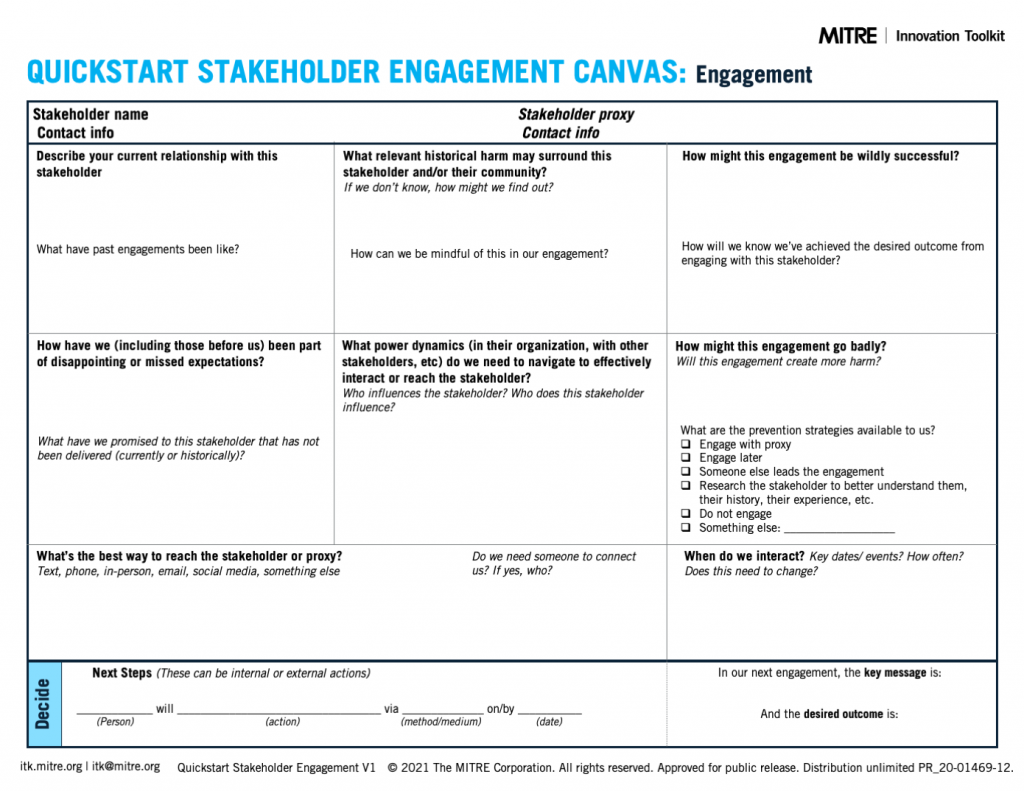Learn more about ITK’s newest tool and the equity lens embedded in it.
– – –
As part of Team Toolkit’s collaboration with the MITRE Social Justice Platform, we are excited to announce the addition of a new tool – the ITK Quickstart Stakeholder Engagement Canvas!
The ITK Quickstart Stakeholder Engagement canvas is a quick way to begin developing a plan for effectively engaging a stakeholder. This tool is best used early in the process, but it’s an important step whenever you need to interact or collaborate with the people involved, interested, or impacted by your project.
This canvas is divided into two complementary sides – “Analysis” and “Engagement”. The “Analysis” side of the canvas helps your team identify and assess a stakeholder’s needs, wants, and influence. It also helps your team get clear on their wants and needs, which will help identify where the team’s priorities do or do not match with the stakeholder.

The “Engagement” side of the canvas helps your team consider how to approach the first (or next) engagement with the stakeholder. It asks your team to consider the context surrounding this stakeholder so that your team can work to avoid any missteps. It also encourages your team to consider two notional scenarios: A wildly successful engagement or a bad engagement. Similar to the Premortem, the practice of imagining these future scenarios will help your team identify potential problems, risks, or blind spots before they occur.
In addition, the embedded equity lens helps your team explore four additional considerations beyond the default to help create more equity-informed engagements. This helps broaden your team’s thinking and raise their collective awareness, both of which can help inspire new thinking and opportunities for innovation.
The first equity-minded consideration asks your team to identify relevant historical events that may continue to impact the stakeholder today, rather than focusing only on present-day conditions. The embedded equity lens asks about past disappointments and historical harms that the stakeholder may have experienced. It prompts your team to consider how they might be more mindful of these occurrences when engaging with the stakeholder.
Another equity-minded consideration that this tool asks about is lived experience (a.k.a. relevant first-hand experience) that the stakeholder may have. This is often an overlooked, but critically important, type of expertise.
The third equity-minded consideration is the explicit discussion of power, which is often imbalanced in inequitable situations. It’s also often uncomfortable to name or discuss. By including power questions on the canvas, it allows for a more open and direct conversation with your team rather than relying on someone to bring it up on their own.
Lastly, the fourth equity-minded consideration is to prompt your team to examine their own biases and assumptions that they may be bringing to this engagement. The ability to notice and reflect are critical to equity driven design thinking, which encourages us to create not just inclusive and diverse solutions, but to create equitable solutions.
While there are many stakeholder-related methods and tools on the market, our goal with this new ITK tool is to help teams quickly get started or get unstuck when thinking through how to engage a stakeholder. We encourage teams to use the ITK Quickstart Stakeholder Engagement in combination with the ITK Stakeholder Identification Canvas or other market tools to begin developing your stakeholder engagement strategy. Revisiting your engagement strategy throughout your effort will ensure that the right set of people, groups, and organizations are involved at the right time.
We hope you find the ITK Quickstart Stakeholder Engagement canvas useful, and let us know what you think in the comments below!
Interested in learning more about other ITK tools with an embedded equity lens?
- Check out the updated Problem Framing canvas and the accompanying ITK blog article which explains the equity lens
- Check out the new Stakeholder Identification canvas and the accompanying ITK blog article which explains the equity lens
- Read more about Team Toolkit’s equity-driven efforts here
- Click on the “Equity Driven Design” category on the right to filter relevant blog articles
- Sign up for our listserv to get the latest updates as more tools are released!

